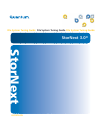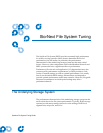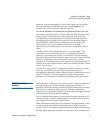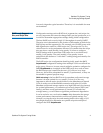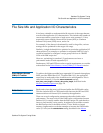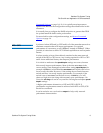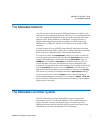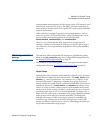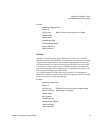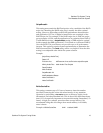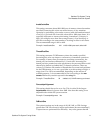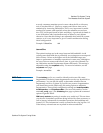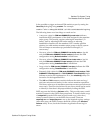
StorNext File System Tuning
File Size Mix and Application I/O Characteristics
StorNext File System Tuning Guide 5
File Size Mix and Application I/O Characteristics
It is always valuable to understand the file size mix of the target dataset
as well as the application I/O characteristics. This includes the number of
concurrent streams, proportion of read versus write streams, I/O size,
sequential versus random, Network File System (NFS) or Common
Internet File System (CIFS) access, and so on.
For example, if the dataset is dominated by small or large files, various
settings can be optimized for the target size range.
Similarly, it might be beneficial to optimize for particular application I/O
characteristics. For example, to optimize for sequential 1MB I/O size it
would be beneficial to configure a stripe group with four 4+1 RAID5
LUNs with 256K stripe size.
However, optimizing for random I/O performance can incur a
performance trade-off with sequential I/O.
Furthermore, NFS and CIFS access have special requirements to consider
as described in the Direct Memory Access (DMA) I/O Transfer
section.
Direct Memory Access
(DMA) I/O Transfer 0
To achieve the highest possible large sequential I/O transfer throughput,
SNFS provides DMA-based I/O. To utilize DMA I/O, the application
must issue its reads and writes of sufficient size and alignment. This is
called well-formed I/O. See the
mount command settings
auto_dma_read_length and auto_dma_write_length, described in the
M
ount Command Options on page 16.
Buffer Cache 0
Reads and writes that aren't well-formed utilize the SNFS buffer cache.
This also includes NFS or CIFS-based traffic because the NFS and CIFS
daemons defeat well-formed I/Os issued by the application.
There are several configuration parameters that affect buffer cache
performance. The most critical is the RAID cache configuration because
buffered I/O is usually smaller than the RAID stripe size, and therefore
incurs a read/modify/write penalty. It might also be possible to match
the RAID stripe size to the buffer cache I/O size. However, kernel
memory fragmentation can defeat attempts to increase the SNFS buffer
cache I/O size (see the
cachebufsize setting described in the Mount



